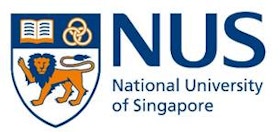The National University of Singapore’s (NUS) Centre for Nature-based Climate Solutions (CNCS), a research centre under the NUS Faculty of Science, with support from HSBC Singapore, have developed technology-driven methods to estimate forest carbon in Singapore, with an outlook to replicate it for Southeast Asia and support nature-based and conservation projects in the region.
Through a combination of remote sensing technology, field measurements, and machine learning techniques, the NUS CNCS research team was able to produce a detailed and spatially explicit evaluation of Singapore’s forest carbon. This is the first carbon map for Singapore which utilises light detection and ranging (LiDAR) data, a remote sensing method using laser scanners mounted on drones or aeroplanes which not only improves accuracy and provides more precise estimates of carbon in trees, but also reduces the time and manpower needed in previous methods that primarily relied on satellite data and manual measurements.
The findings signify a significant step forward in understanding and preserving Singapore’s forest ecosystems, while offering valuable insights for wider conservation efforts in the region. By estimating forest carbon in broader landscapes, this methodology has the potential to enable the efficient production of spatially explicit forest carbon estimations for Southeast Asia. Such information could help governments and organisations to identify the precise locations of areas of interest to protect or invest in.
Frances Chen, Head of Sustainability, ASEAN at HSBC said, “The world cannot achieve the transition to a net-zero economy if we are not nature positive. Nature-based solutions are a critical component in tackling the effects of climate change – this is especially so for Southeast Asia, which is one of the fastest-growing yet also one of the most vulnerable regions to climate change. At HSBC, we believe that the finance sector has a role to play in scaling up nature-based solutions. By supporting NUS CNCS on this innovative project, we hope to facilitate better understanding of the benefits of nature-based solutions through quantification and measurement, which can help to attract nature-related financing in Singapore and the broader Southeast Asia region.”
Professor Koh Lian Pin, NUS Associate Vice President and Chief Sustainability Scientist, and Director of NUS CNCS, emphasised the collaborative effort behind this milestone achievement.
“This project was made possible through close collaboration between the private sector, academic, and governmental bodies such as Singapore Land Authority and the National Parks Board,” he said. “Singapore’s role as a test-bedding site for the development of this methodology showcases its potential for application in the forest-rich Southeast Asia region,” he elaborated.
The LiDAR-predicted carbon maps generated by the team showed that Singapore’s forests contained an estimated total carbon stock of up to 1.37 teragrams of carbon (Tg C) in 2019. In the context of climate mitigation, this equates to approximately up to 2.74 per cent of the nation’s 2021 CO2 emissions from fossil fuels.
This technology-driven approach provides valuable insights into the distribution of carbon across Singapore’s terrestrial forests, freshwater swamp forests, and mangroves (Annexe A). Notably, forests with higher carbon stock are predominantly found in Singapore’s protected nature reserves: Bukit Timah, Central Catchment and Sungei Buloh. The carbon stock in these protected reserves is comparable to pristine floodplain forest in Juruá, Brazil within the Amazon, and secondary peat swamp forests in Central Kalimantan of Borneo, Indonesia – both recognised tropical forests. This underscores the effectiveness and importance of conservation and restoration efforts in preserving Singapore’s carbon sinks.
For more information on the findings of the project: ‘Technology-driven methods for estimation of nature-based carbon stocks in Singapore’, please refer to the NUS CNCS website for the detailed report.
Publish your content with EB Publishing
It's about who you reach. Get your news, events, jobs and thought leadership seen by those who matter to you.









